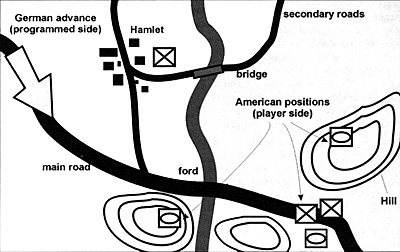 What follows are "after action" reports of two solo games using the same programmed scenario from and the Piquet rules system. In both games the objectives, forces, and terrain are the same - only the initial disposition of forces were different because they are generated randomly according to the scenario. These examples of play should illustrate how programmed scenarios and rules using a random sequence of play can add both intellectual depth and entertainment value to the solo wargaming experience.
What follows are "after action" reports of two solo games using the same programmed scenario from and the Piquet rules system. In both games the objectives, forces, and terrain are the same - only the initial disposition of forces were different because they are generated randomly according to the scenario. These examples of play should illustrate how programmed scenarios and rules using a random sequence of play can add both intellectual depth and entertainment value to the solo wargaming experience.
Scenario 4, "Holding Action" from Grant's Programmed Wargame Scenarios, pits an advancing force of superior numbers against a smaller force which must perform a delaying action along a hilly area that straddles a road. My interests lately have been the Western Front during the last months of the Second World War. Therefore, I used this scenario to portray a German counterattack during the Allied advance through Northern France, such as the one near Mortain in early August 1944. My advancing force consisted of a three platoons of heavy German armor (Tiger I and Panzer IV), two Wehrmacht infantry platoons (one mechanized), a few scattered SP assault guns (Stug III, Jagdpanzer IV), and a mixed recon platoon of Puma armored cars and obsolete Panzer 111's. The beleaguered Americans tasked with delaying this impressive force consisted of four platoons of straight-legged infantry, two platoons of medium Sherman tanks, a platoon of light M-5 Stuart tanks, and a Typhoon fighter-bomber kindly provided by the British for close air support.
Using the programmed objectives and reactions of the Red (German) forces and playing with a free hand as the Blue (American) commander, I played this scenario twice through with very different results. In the first run through, the combined luck of the initiative die roll (1D10 described earlier) and the Sequence Deck cards drawn by the German side allowed the Germans to advance down the main road a fair distance before the Americans began to react. The assault guns in the German advanced guard were able to engage one of the Sherman platoons and knocked it out of action before it could fire a shot. In other words, the Germans caught the Americans asleep at the wheel. Without a random sequence of play like that created by the Piquet system, this particular "fortune of war" would probably not have happened this way.
After this initial fumble, the remaining American armor proved equally ineffective in stopping the German advance as it followed the programmed objective and responses. The German armor pressed down the road and finally exited the southeast corner map. The American infantry, straddling the road between two hills, was simply bypassed by the rapidly-advancing Panzers, and was beaten back by German mechanized infantry when it attempted to close assault the passing tanks. An attack by the Typhoon was woefully ineffective. At the conclusion, the Americans lost more than two-thirds of their armor while the Germans lost only a couple of the Panzer IV tanks and two armored cars. The Germans were able to successfully complete their mission objectives and were clearly the winners.
The second play of this scenario was markedly different. This time the randomly-generated initial placement deployed two American infantry platoons in the town (see map). This small blocking force drew the first blood of this game by using its bazookas against a Jagdpanzer IV which had wandered into town hunting for enemy tanks. The main action, however, took place on the road that channeled the Germans' advance toward their objective. This time the die rolls and the Sequence deck favored the Americans. The Shermans were the quicker on the draw and they opened up on the advancing Panzers from close range and from a flanking position.
The Americans drew back-to-back Brilliant Leader cards (the Piquet equivalent of "wild cards"), which were both used as Armor Target Acquisition, allowing the Shermans to fire three times in a row before the Germans could respond and completely destroying a platoon of Panzer IV's. The very next card drawn was a Heroic Moment, which enables the next card drawn to be applied twice.
The next card drawn by the Americans, as luck would have it, was Aerial Phase. In comes the Typhoon! This time, the road-bound Tigers easily fell prey to the cannon and air-toground rockets of the attacking fighter bomber. The scenario effectively ended in the first turn, like a fight in which the favored boxer crosses the ring at the opening bell of round one and is felled by the first punch of his underdog opponent. The Americans in this instance not only delayed the Germans, they flat out defeated them.
While these two plays resulted in very different outcomes, either was a plausible "real world" result. This leads me to believe I was successful in combining two elements - Grant's programmed scenarios book and the Piquet system using a random sequence of play - into a solo gaming experience that was neither predictable nor artificial. 1 recommend Grant's Programmed Wargames Scenarios (and in fact anything by Charles Stewart Grant), and the Piquet rules to anyone interested in solo wargaming.
Programmed Scenarios and Random Sequences: Solo Gaming
Back to MWAN # 130 Table of Contents
Back to MWAN List of Issues
Back to MagWeb Magazine List
© Copyright 2004 Hal Thinglum
This article appears in MagWeb.com (Magazine Web) on the Internet World Wide Web.
Other articles from military history and related magazines are available at http://www.magweb.com